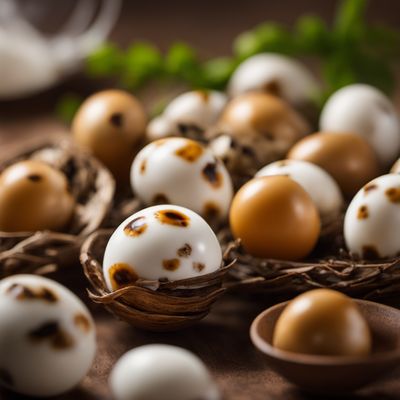
Ingredient
Common quail eggs
Tiny Delights: Exploring the World of Quail Eggs
Quail eggs are small, speckled eggs that are about one-fifth the size of a chicken egg. They have a delicate shell that is slightly harder to crack, revealing a vibrant yolk and a mild, creamy flavor. The texture is smooth and velvety, making them a delightful addition to salads, appetizers, or as a garnish. Quail eggs are often enjoyed boiled, fried, or pickled, and their small size makes them perfect for bite-sized canapés or decorative presentations.
Origins and history
Quail eggs have been consumed for centuries and are believed to have originated in East Asia. They have a rich history in various cultures, including Chinese, Japanese, and European cuisines. In Japan, they are a popular ingredient in bento boxes, while in France, they are used in traditional dishes like quiche Lorraine. Quail eggs are also associated with symbolism and are often used in festive celebrations or as a symbol of prosperity and fertility.
Nutritional information
Quail eggs are a good source of protein, vitamins, and minerals. They are low in calories and contain essential nutrients like vitamin B12, selenium, and choline. Each quail egg provides approximately 14 calories, making them a nutritious addition to a balanced diet.
Allergens
None known.
How to select
When selecting quail eggs, look for clean, uncracked shells with no signs of discoloration or damage. The shells should feel firm and not have any unpleasant odors. If possible, choose eggs that are refrigerated or stored in a cool environment to ensure freshness.
Storage recommendations
To maintain the freshness of quail eggs, store them in the refrigerator at a temperature between 35°F and 40°F (1.7°C and 4.4°C). Keep them in their original carton or transfer them to an airtight container to prevent moisture loss. Use quail eggs within 2 to 3 weeks of purchase for the best quality.
How to produce
Quail eggs can be produced by raising quails in a suitable environment. Quails require a well-ventilated coop or cage with access to clean water and a balanced diet. They can be raised in small spaces and are relatively low-maintenance compared to other poultry. However, it is important to research and follow proper guidelines for quail husbandry to ensure their well-being and optimal egg production.
Preparation tips
Quail eggs can be boiled for 2 to 3 minutes for a soft-boiled yolk or 4 to 5 minutes for a hard-boiled yolk. They can also be fried sunny-side up or used in omelets, frittatas, or scrambled eggs. Quail eggs are a popular choice for garnishing salads, sushi, or canapés due to their small size and attractive appearance. They can also be pickled or used in baking for a unique twist on traditional recipes. To peel quail eggs easily, gently tap them on a hard surface and roll them between your hands to loosen the shell before peeling.
Substitutions
Chicken eggs can be used as a substitute for quail eggs in most recipes, although the size difference should be taken into account. If using chicken eggs as a substitute, adjust the cooking time accordingly. Alternatively, you can use duck eggs, which are larger than quail eggs but have a similar flavor and texture.
Culinary uses
Quail eggs are commonly used in Asian cuisines, such as Japanese sushi, Chinese dim sum, or Vietnamese banh mi. They are also popular in European dishes like Scotch eggs, quiches, or as a topping for salads. Quail eggs can be incorporated into hors d'oeuvres, appetizers, or served as a standalone dish, showcasing their delicate flavor and visual appeal.
Availability
Quail eggs are commonly available in Asia, Europe, and North America. They can be found in specialty grocery stores, farmers markets, or Asian supermarkets. Quail eggs are also cultivated in countries like Japan, China, France, and the United States.
